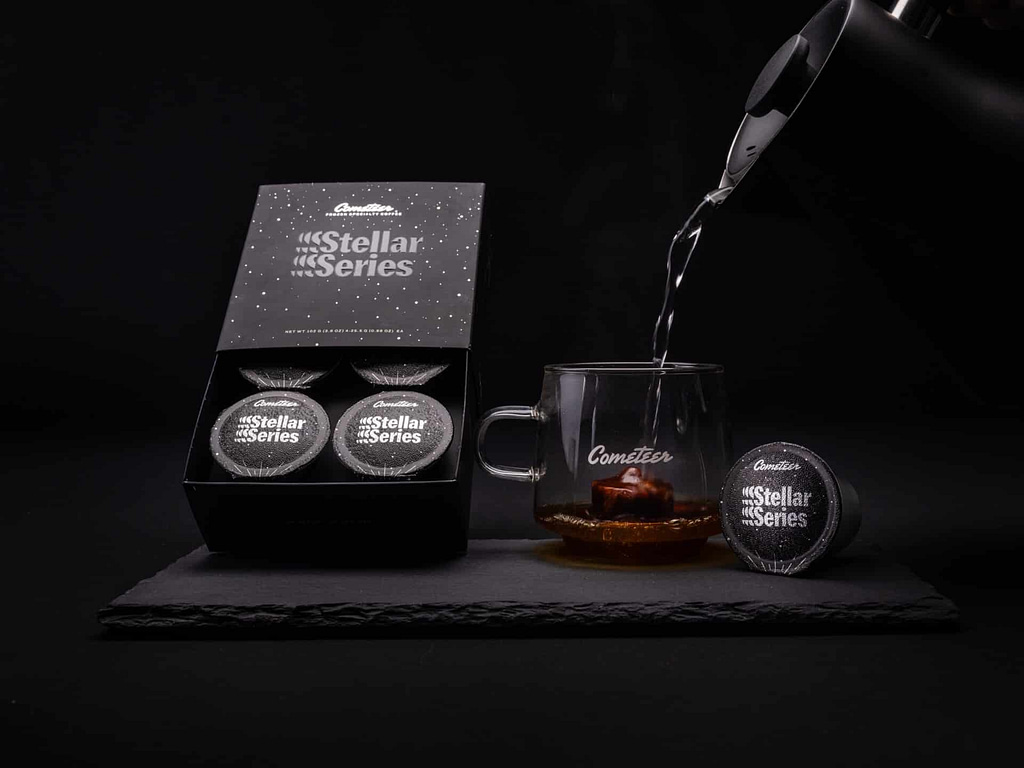[[{“value”:”

Could flash-freezing be the key to making the world’s rarest coffees more accessible?
Freezing high-grade, small-batch beans is nothing new. The specialty industry has been using the method for years to time-capsule coffees before age and the elements get the better of them. However, this process has largely remained in the café setting and been hard for home brewers to access – until Cometeer came along.
The American coffee technology company aims to make creating an exceptional cup of coffee at home incredibly convenient. Over the course of five years, Founder Matt Roberts developed a custom flash-freezing process with the help of George Howell, the “godfather of specialty coffee”.
“The goal of flash-freezing technology is to preserve more flavour and aroma than any other coffee format,” says Alex Kaplan, Head of Coffee at Cometeer.
“Our research has shown that the faster you freeze coffee, the more volatile aromatic compounds you preserve. This is because complex aromas are made up of inherently unstable volatile chemicals, which degrade over time via oxidation, volatilisation, and hydrolysis. Flash freezing halts these chemical degradations, allowing us to preserve the complexity and nuance of each coffee.”
The Cometeer team select beans from some of the best farms and roasteries around the world, brew them for optimum flavour, and then use liquid nitrogen to flash-freeze them. They’re packaged in capsules, which consumers can either defrost and mix with milk, water, or ice for chilled coffee, or pair with hot water or milk for a filter coffee or latte in seconds.

Delivering high quality coffees to home consumers has been a founding priority for the company and its latest release sees some of the world’s best beans landing on consumers’ doorsteps. The new Stellar Series, of which the first edition launched in October 2024, features three coffees that have been ranked among the top in their country by Cup of Excellence.
“All three of our first Stellar Series coffees are the Geisha varietal, from some of the best farms on Earth,” says Kaplan.
“Included in the Series is Sebastian Ramirez’s legendary White Honey Geisha, roasted by Black & White Coffee Roasters. Ramirez is known for his pioneering approach to post-harvest coffee processing, enhancing the flavours of each bean through innovative techniques like carbonic maceration and anaerobic fermentation. This Geisha coffee is exceptional due to its complex floral flavours, complemented with the bright sweetness of lemon and a rich body like dulce de leche.”
Also included in the collection is Gesha Village Estate, roasted by Gorge Howell Coffee, and Hacienda La Esmeralda Natural Geisha, roasted by Klatch Coffee.
“The Gesha Village Estate is a world-renowned farm that has brought Gesha coffee cultivation back to its roots in Ethiopia. Gesha Village is known for its cultivation of heirloom coffee varietals, with quality levels that have earned it international esteem, including selling some of Ethiopia’s highest ever priced coffees,” says Kaplan.
“Hacienda La Esmeralda may be the world’s most famous coffee farm. Known for pioneering the now world-famous Geisha variety, the Peterson family who run the farm have established themselves as some of the world’s most respected coffee producers. This coffee is a beautiful example of their naturally processed Geisha, with a rich fruity flavour to complement its complex floral aromatics.”
Kaplan says providing a product that’s sustainable is as important as getting these special coffees under the noses of everyday consumers. While some ground coffees have a shelf-life of around three months, Cometeer’s capsules can last 36, which it says reduces waste from coffee that’s no longer at its prime. The capsules, made from aluminium, are fully recyclable.
“Our mission is to create massive positive change in the coffee-verse. From farm to roaster to consumer,” says Founder Matt Roberts.
“More fair, more delicious, more sustainable, more future-forward.”
For more information, visit cometeer.com
The post Is the future of coffee frozen? appeared first on Global Coffee Report.
“}]]


